
When one thinks of prehistoric Native Americans, an image of small, mobile groups or tribes of hunter-gatherers immediately comes to mind. In truth, however, they were also very much a society of farmers, making their living within permanent settlements where a variety of crops or domesticated plants were grown and harvested. Now, a collaborative study conducted by researchers from the University of Connecticut (UConn), the University of Utah, Troy University, and California State University, Sacramento is examining the growth in agriculture 7,500 to 5,000 years ago among the ancient Native Americans and the social implications of this shift. The study focuses on the interior part of Eastern North America.
“There’s no good name for the region really, because it’s part of the lower mid-west and upper south east,” explains researcher and Ph.D. student Elic Weitzel of UConn. “We’re talking about states like Tennessee, Missouri, Illinois, Kentucky, Ohio—this general region.” Such a study has never been conducted before.
Weitzel is pursuing a Ph.D. in anthropology, and although he is trained as an archaeologist, he thinks of himself as more of a “human ecologist.” Weitzel, along with his research team, have used pre-existing data sets collected by archaeologists over the years to reexamine this region and ask new questions about the growth and development of agriculture and the ways in which this shift changed the social climate of a region. “The cool thing about this research is that we didn’t actually do any excavations,” he explains. “This is all based on previous studies that archaeologists have done, and it’s part of this push toward big data in science disciplines at large. Archaeologists seem to be amassing these large data sets, and because of that increasing cooperation among researchers, people like me and my colleagues can now ‘mine’ that data and reanalyze things on a broader scale than any individual archaeologist would have been able to do in years past.”
Growth in agriculture
Using these existing data sets in archaeology and ecology, the research team examined the region and found that in using the ecological model, they were able to predict where prehistoric individuals should live on a landscape in relation to population density and the quality of different habitats. “We really applied that kind of ecological model to the archaeological data sets of where humans were living in the past on the landscape,” Weitzel explains. “What this predicts is that as the population density in an area increases, people are going to first live in the highest quality locations on the landscape. As the population density grows there, they are going to expand to the second highest quality location, and then the third highest quality location.” This pattern is what is observed before the introduction of farming in the region. It was a hunter-gatherer pattern of infilling the landscape.
“Then, when you have farming, there’s a bit of a reversal of that pattern,” Weitzel goes on. “All of the sudden you’ve got this new economic activity that really requires people to cooperate with each other. People start moving back into those high-quality locations they had previously left, so we see this actual increase with the metric of site quality that we see in the data.” With the shift toward farming taking place 7-7.5 thousand years ago came an incentive to live closer to other people and cooperate with other people in order to manage and maintain crops. “We used this ecological, theoretical model to make these predictions, and then looked at the locations of the sites themselves in reference to what’s called ‘net primary productivity,’” Weitzel explains. “This is essentially just the measure of energy availability in an environment. Essentially plants photosynthesize to produce energy, and you can do all sorts of things with satellite imagery nowadays where we can run these calculations and end up with an image of a landscape with net primary productivity calculated for all these different cells in this kind of image. We use that data and look where the sites were located, and just statistically analyzed the changes through time, and our findings really fit very well with this theoretical model that we came at it from.”
_____________________________
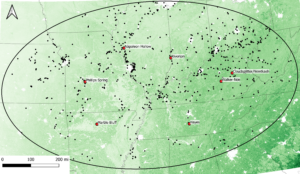
Map depicting several key sites in the lower mid-west and upper south east; black dots depict sites analyzed in this study, while red, labeled dots depict sites with the earliest evidence for domestication in the region. Courtesy of Elic Weitzel.
_____________________________
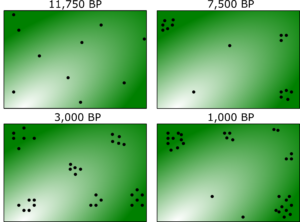
A schematic, hypothetical map used by researchers to visualize their habitation patterns by time period. Courtesy of Elic Weitzel.
_____________________________
Some of the crops being domesticated by these groups would be familiar to people now, such as squash and sunflowers, but many other domesticated plants in this region still exist on the landscape in their wild forms and are unrecognizable to modern humans. “The nature of these plants was such that they were really best harvested quickly in the autumn, and so that’s what inspired this shift towards a new incentive to cooperate with people,” he explains. “Certainly, folks are always cooperating, but now that you’re trying to target crops, that inspires the shift toward [the greater] cooperation that we see.” But as we shift to domesticating and harvesting crops, we see several moving parts in these societies shift as well, namely the new need for defense. “Now that you’re targeting these crops that are on fixed locations on the landscape—unlike the animal population that moves around—you’ve got to start defending these crops, and your territory as a result.” Along with cooperation comes new forms of competition as well. “People are now defending their territories, they’re attacking other people, they’re launching raiding parties and they’re scalping and beheading and taking trophies from battle,” Weitzel goes on. “These two broad umbrellas of cooperation and competition really frame a lot of the later social changes that occurred within Native American society for a millennium afterwards. It is right at this time that you are also seeing a lot of shifts more broadly in how people are organizing themselves. A little later after this point in time is when you start seeing the appearance of social complexities and social hierarchy, and eventually later on you’ve got your famous Mississippian civilizations with their famous mound sites, but all of these changes are really undergirded by the more fundamental shift that occurred thousands of years earlier in the form of domestication and the management of crops that really lead to these two changes in cooperative and competitive dynamics.”
__________________________
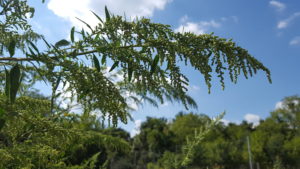
Chenopod, a crop domesticated by humans in the region between 7-7.5 thousand years ago. Courtesy of Dr. Stephen B. Carmody.
__________________________
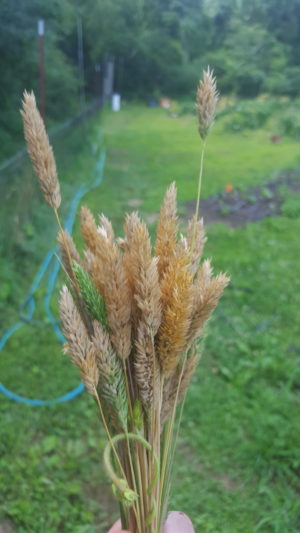
Maygrass, a crop domesticated by humans in the region between 7-7.5 thousand years ago. Courtesy of Dr. Stephen B. Carmody.
__________________________
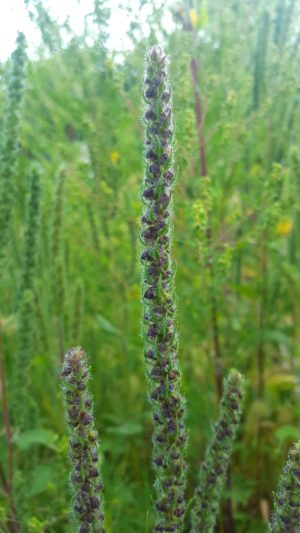
Sumpweed, a crop domesticated by humans in the region between 7-7.5 thousand years ago. Courtesy of Dr. Stephen B. Carmody.
__________________________
Increase in inter-group violence
As these changes in cooperative and competitive dynamics come about, we can also observe an increase in violence, suggest the researchers. “With that shift toward becoming a farmer, we expected that sites were actually going to start aggregating together on the landscape, kind of clustering, and might be doing so in these high-quality locations,” Weitzel says. “Where they’re living on the landscape and how clustered and in which types of habitats they are can actually tell you something about how common-place it is for interpersonal cooperation, or perhaps intergroup competition at the same time.” By analyzing the available data, specifically the site distributions, the research team was able to pull together a data set on the frequency of “trophy taking” in the archaeological record. Trophy taking includes actions such as scalping, beheading, or dismemberment of some sort. Weitzel explains, “[With] certain groups, after some kind of battle would take place, a fight or conflict, the victors would remove body parts from the losers as a symbol that they won, and they were good warriors and fighters. The frequency of trophy taking in the archaeological record really coincides perfectly with the changes that we’re seeing in settlement patterns around 7-7.5 thousand years ago.” Evidence suggests that hunter-gatherer groups engaged in raiding and intergroup violence in North America, but there is no evidence that is known to us yet for this clear signature of trophy taking. “Before that [7-7.5 thousand years ago] you’ve got fractures and broken bones and imbedded projectile points, so there is violence for sure going on, but archaeologists have for a while now thought that there’s something different going on when you see this appearance of trophy taking.”
Much of the theoretical modeling of this study is informed by evolutionary theory, or the Darwinian idea of adaptation and fitness, according to Weitzel. The way people distribute themselves as a population across the landscape has to do with the individual choices people make based on their fitness, their reproductive success, the quality of the environment, and the access and opportunities available to them. “That kind of evolutionary thinking that we would apply to humans is often emphasized competitively, through violence and interpersonal competition and group competition, but it’s really important for us to remember that cooperation is just as important in terms of human evolution and human adaptation as competition is,” he says. These two dynamics, competition and cooperation, are fundamentally important and go hand in hand. “We are profoundly good at violence. There is, of course, a lot of discussion on this. We are capable of incredible, horrific acts of violence, but simultaneously, we are capable of incredible acts of cooperation. We must understand that these things are really two sides of the same coin; cooperation with your group members is often times necessary to compete with outsiders. That is the broader narrative here, and that’s the really important thing to remember.”
While the recently published study focuses heavily on this time period of 7-7.5 thousand years ago, Weitzel points out that around 3,000 years ago, we see a reversal of this pattern. “We suddenly start to see people leaving those high-quality locations, and we start to see almost the absence of trophy taking whatsoever.” Between 1-3,000 years ago, trophy taking becomes incredibly rare in comparison, and we can observe a shift in the region that seems to have alleviated some of the pressure on these groups as people start expanding into lower quality habitats and group violence is no longer as prominent in the material record.
Because the data in this study is being pulled and reanalyzed from previous work, no excavations are necessary to further this research. However, this team has plans to continue working with these large databases to investigate these questions further. Weitzel says, “There are a lot of great questions to be asked about the shift from foraging to farming in terms of how exactly this cooperation was maintained, because it’s tough to get a bunch of people on the same page, doing the same thing at certain times. In this time when we are seeing this shift, there is actually no clear evidence yet for a strong social hierarchy, so this is a bit more of a social heterarchy—a kid of less vertically structured and more horizontally structured system. This really interesting question can be asked about how exactly they were cooperating and overcoming these collective action problems they were faced with when trying to cooperate, and that’s something that I’m really interested in looking into in the future.”
Cover Image, Top Left: by Felix Mittermeier





